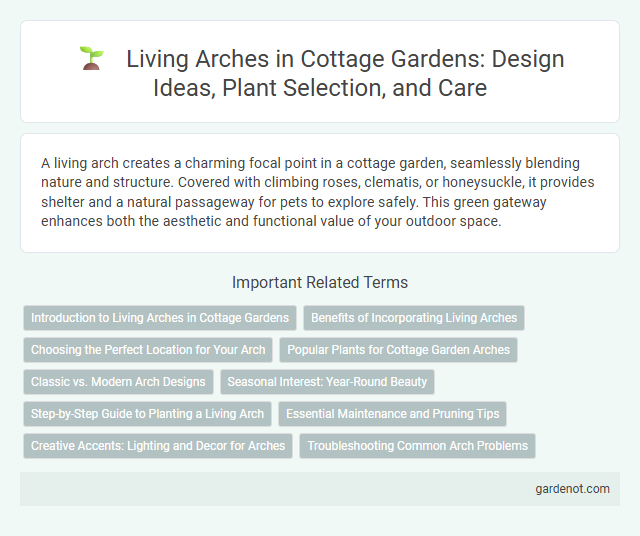A living arch creates a charming focal point in a cottage garden, seamlessly blending nature and structure. Covered with climbing roses, clematis, or honeysuckle, it provides shelter and a natural passageway for pets to explore safely. This green gateway enhances both the aesthetic and functional value of your outdoor space.
Introduction to Living Arches in Cottage Gardens
Living arches in cottage gardens combine functional design with natural beauty by using climbing plants trained over curved structures to create elegant, green gateways. Common plants for living arches include jasmine, clematis, and climbing roses, which thrive in the relaxed, informal environment characteristic of cottage garden styles. These arches not only enhance garden aesthetics but also provide habitat for pollinators and support vertical growth in limited spaces.
Benefits of Incorporating Living Arches
Incorporating living arches in a cottage garden enhances vertical space by supporting climbing plants like roses and clematis, creating natural privacy screens and shaded walkways. These structures promote biodiversity by attracting pollinators such as bees and butterflies, contributing to a healthier garden ecosystem. Living arches also add aesthetic charm and can serve as focal points that seamlessly blend architecture with lush greenery.
Choosing the Perfect Location for Your Arch
Selecting the ideal location for a living arch in your cottage garden involves assessing sunlight exposure to ensure plants thrive, typically requiring at least six hours of direct sunlight daily. Consider proximity to garden paths or seating areas to create inviting focal points that enhance both aesthetics and functionality. Soil quality and drainage must be evaluated to support healthy root growth and long-term structural stability of the arch.
Popular Plants for Cottage Garden Arches
Popular plants for cottage garden arches include climbing roses, clematis, and honeysuckle, valued for their vibrant blooms and fragrant appeal. Wisteria and jasmine are also favored for their cascading flowers and ability to create a lush, natural canopy. Incorporating plants like passionflower and sweet pea enhances the arch's texture while attracting pollinators and supporting biodiversity.
Classic vs. Modern Arch Designs
Classic living arches in cottage gardens feature ornate wrought iron or wooden latticework, blending traditional craftsmanship with climbing roses and clematis for a timeless aesthetic. Modern arch designs emphasize minimalist materials like sleek metal or PVC, offering clean lines and structural simplicity that complement contemporary planting schemes. Both styles create inviting garden entrances, with classic arches enhancing rustic charm and modern versions providing a streamlined, artistic focal point.
Seasonal Interest: Year-Round Beauty
A living arch in a cottage garden provides year-round beauty through seasonal interest by incorporating a mix of evergreen plants, flowering vines, and deciduous climbers. Spring brings vibrant blooms like clematis and wisteria, while summer showcases lush green foliage and fragrant honeysuckle. In autumn and winter, plants like ivy and winter jasmine maintain structure and color, ensuring continuous visual appeal across all seasons.
Step-by-Step Guide to Planting a Living Arch
Choosing sturdy plants such as climbing roses, clematis, or jasmine is essential for creating a living arch in a cottage garden. Begin by installing a strong support structure like a metal or wooden frame and prepare well-drained soil enriched with organic compost for healthy root growth. Train young plants to grow along the frame by gently tying stems and regularly pruning to promote dense foliage and abundant blooms.
Essential Maintenance and Pruning Tips
Living arches in cottage gardens require regular pruning to maintain their shape and encourage healthy growth of climbing plants such as roses or clematis. Essential maintenance includes trimming back dead or overgrown branches in late winter or early spring before new shoots emerge. Applying mulch at the base helps retain moisture and suppress weeds, promoting robust plant development on the arch structure.
Creative Accents: Lighting and Decor for Arches
In a cottage garden, living arches serve as enchanting focal points that blend natural growth with artistic design, enhancing the overall aesthetic. Creative accents such as fairy lights, lanterns, and hanging glass orbs add warmth and visual interest, illuminating pathways and framing seasonal blooms. Integrating floral wreaths and vintage-inspired decor elevates the arch's charm, making it a captivating gateway and photo-worthy feature in the landscape.
Troubleshooting Common Arch Problems
Living arches in cottage gardens often face issues like uneven growth, pest infestations, and structural weakness due to improper support. Regularly inspecting the frame for stability, pruning overgrown vines, and applying organic pest control can help maintain the arch's health and appearance. Ensuring proper irrigation and sunlight exposure also prevents common problems such as mold and stunted growth.
Living arch Infographic

 gardenot.com
gardenot.com